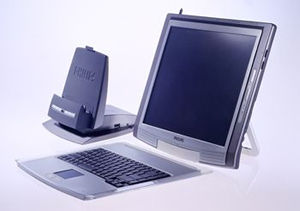Smart Displays: a first look

Smart Display features
A Smart Display is a cordless LCD monitor with a passive touch-sensitive screen, which connects to your main PC over an 802.11b (Wi-Fi) wireless network. Extras such as a pop-up soft-keyboard for text entry (the Grafitti-like Transcriber is also supported) and built-in speakers for playing music are offered. Some models have a docking unit that provides wired PC, keyboard and mouse connections, allowing them to be used in desktop as well as portable mode.

Microsoft has signed up a number of hardware partners including ViewSonic, Philips, NEC, Fujitsu and TriGem. Working hardware from Philips and ViewSonic was demonstrated at the end of November in London. Smart Displays from ViewSonic will be available in the US from 8 January 2003, and a European launch will follow some time during the first quarter of 2003. Philips has yet to commit to launch dates, but its hardware, which comprises a 15in. display and a separate keyboard, is extremely stylish. Out of the box ViewSonic is offering the display itself, an 802.11b USB adapter for your main computer (the Smart Display has 802.11b built in), and an upgrade to Windows XP Professional for your host PC, from any version of Windows back to 98. Yes, you did read that right. The kit includes an upgrade to Windows XP Professional. This consumer-targeted device does not work with Windows XP Home Edition, as that lacks the Remote Desktop Protocol (RDP) that a Windows CE-powered Smart Display requires to connect to the host PC.
Pros and cons of Smart Displays
Quite clearly there are definite advantages in having a portable wireless device around the house. Anyone with a wireless network and a notebook PC will confirm the convenience of being able to work anywhere, look at photos stored on your PC, listen to MP3 music and so on. Add wireless access to a high-speed Internet connection to the mix, and the experience also becomes liberating and empowering -- at least in the narrow IT-focussed definitions of these terms.
But you don’t need a Smart Display to get this kind of convenience, empowerment and liberation. Any old 802.11b-enabled notebook can deliver the same benefits, and offer a few added advantages into the bargain. Notably, you can only have one Smart Display per host PC, while a wireless network around the home lets you connect up many devices. When the Smart Display is connected to your main PC, the PC can’t be accessed by another user -- wireless networking for file and Internet access sharing does not see multiple access as a problem.
There is also an issue with the fact that the 802.11b wireless networking standard is currently used in Smart Displays. This doesn’t cope well with streaming video, and when the faster 802.11a becomes widespread and you want to view video received via a broadband Internet connection on a Smart Display, it will be ‘upgrade the hardware’ time.
Too expensive?
The real killer for Smart Displays, though, is that they become useless when out of range of a host PC. The hardware runs Windows CE, but cannot operate independently of a Wi-Fi-connected PC running Windows XP Professional.
This might be OK for hardware that cost a couple of hundred pounds, but Smart Displays are going to be considerably more expensive than that. UK prices have not yet been fixed, but in the US ViewSonic’s 10in. AirPanel V110 will retail at $999, with the 15in. V150 model coming in at $1,299. For this money, even the earliest of early adopters might be tempted to look around for alternatives. If they do, they will find not only notebooks, which might be a bit ‘old hat’ for such techno-adventurers, but also a whole range of new eye-catching Tablet PCs. Many of these offer flip-over screens that can easily mimic the look of a Smart Display, and they function independently as proper computers. ZDNet video: COMDEX: ViewSonic's "smart" monitor on display